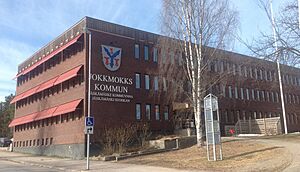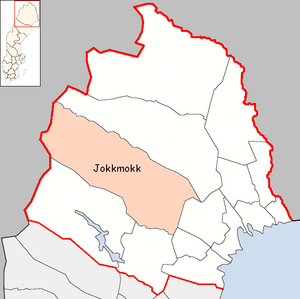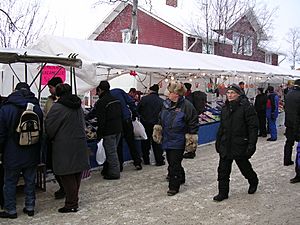Jokkmokk Municipality facts for kids
Quick facts for kids
Jokkmokk Municipality
Jokkmokks kommun
|
||
|---|---|---|

Jokkmokk Municipal Building
|
||
|
||
 |
||
| Country | Sweden | |
| County | Norrbotten County | |
| Seat | Jokkmokk | |
| Area | ||
| • Total | 19,477.24 km2 (7,520.20 sq mi) | |
| • Land | 17,735.36 km2 (6,847.66 sq mi) | |
| • Water | 1,741.88 km2 (672.54 sq mi) | |
| Area as of January 1, 2010. | ||
| Population
(June 30, 2012)
|
||
| • Total | 5,194 | |
| • Density | 0.266670/km2 (0.69067/sq mi) | |
| Time zone | UTC+1 (CET) | |
| • Summer (DST) | UTC+2 (CEST) | |
| International area code | +46 | |
| ISO 3166 code | SE | |
| Province | Lapland | |
| Municipal code | 2510 | |
Jokkmokk Municipality is a large area in northern Sweden, located in Norrbotten County. Its main town, or seat, is Jokkmokk. The name Jokkmokk comes from the Sami words for "river" and "bend," because the town is near a bend in a river.
This municipality is the second largest in Sweden by land area. It covers about 19,477 square kilometers (about 7,520 square miles). That's a bit smaller than the country of Slovenia! Jokkmokk Municipality has been this big since municipalities were first created in Sweden in 1863.
Contents
History of Jokkmokk
The name Jokkmokk has been used for a long time, even in historical court districts. When the municipality got its current borders in 1971, it also got a special coat of arms.
Symbols on the Coat of Arms
The symbols on the coat of arms tell a story about the area. They show a hydro plant, which represents the important power stations here. There's also a symbol of Luleå, a city Jokkmokk was connected to long ago. Finally, you can see traditional Sami hammers, honoring the indigenous people of this region.
Exploring Jokkmokk's Geography
Jokkmokk Municipality is located in the Scandinavian Mountains in Swedish Lapland. It's a very quiet place with few people living there. For thousands of years, reindeer herding Sami people have lived in this area. Because of its special history and nature, a large part of the municipality is protected as a UNESCO World Heritage Site. This protected area is called the Laponian area.
Natural Wonders: Laponian Area
The Laponian area has two main parts: flatlands in the east and mountains in the west. It's a great place for people who love nature and want to explore the amazing wilderness. You can find good starting points for adventures, like the Kvikkjokk basecamp, which offers trips and has a nice hostel.
Seasonal Magic: Lights and Sun
Because Jokkmokk is so far north, you can see the beautiful aurora borealis (also known as the Northern Lights) all winter, from November to March. In the summer, during June and July, you can experience the midnight sun. This means the sun never fully sets, and it stays light even at night!
Rivers and Hydropower
The Lule River and the Lesser Lule River flow through Jokkmokk. These rivers are very important for making hydroelectricity. In fact, Jokkmokk has many of Sweden's largest hydroelectric plants. Six of the ten biggest ones are here! Some of the largest include Harsprånget (977 MW), Porjus (480 MW), and Messaure (460 MW). There are 11 hydroelectric plants in total in the area.
Main Towns and Villages
Jokkmokk Municipality has three main towns, also called localities. The biggest one is the municipal seat.
| # | Locality | Population |
|---|---|---|
| 1 | Jokkmokk | 2,976 |
| 2 | Vuollerim | 800 |
| 3 | Porjus | 317 |
Other smaller places in the municipality include Udtja, which is a Sami reindeer herding camp, and the village of Puottaure.
Attractions and Activities
Jokkmokk Municipality is home to four amazing national parks: Sarek, Muddus, Padjelanta, and Stora Sjöfallet. Each park has its own unique features.
Visiting National Parks
These national parks are popular with tourists all year. However, the darkest and coldest months (November to January) are not recommended for beginners. The best time for sunshine and winter fun is from February to April. During this period, the snow is deep, and the days are long. You can easily explore the parks by skis. Remember, snowmobiles are not allowed inside the national parks.
Summer Adventures
Summer in Jokkmokk is short but exciting. The snow melts from May until late October or early November. Jokkmokk has a continental climate, which means temperatures can be very different. It can reach over 30 degrees Celsius in summer and drop to -40 degrees Celsius in winter! In summer, hikers and nature lovers visit the national parks. This is also when most parts of the parks are easiest to reach.
Important Summer Tips
Be aware that there can be many mosquitoes in the summer. Also, when driving, watch out for reindeer. They often seek shelter from mosquitoes near roads. Collisions with reindeer are common in northern Nordic countries, so drive carefully!
Autumn Colors
Fall is also short, but the wide forests turn into a beautiful display of colors. This is a great time for hiking. However, temperatures can change quickly, so the mountainous parts of the national parks can be tricky if you are not prepared.
Other Fun Things to See
Jokkmokk is very famous for its Sami market. This market happens on the first weekend of February every year and has been held for over 400 years! It started as a place for traders from all over the region to meet. Now, it's a week-long cultural event with talks, art shows, concerts, and much more.
Mining in Jokkmokk
There are deposits of iron ore in the Jokkmokk region. One proposed mining project is the Kallak mine. This mine has faced opposition from activists. It is located between the villages of Björkholmen and Randijaur. This area is important because it is used by the Sami community of Jåhkågasska tjiellde for their reindeer to graze in winter.



